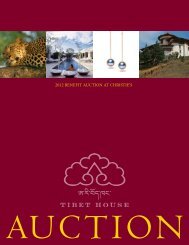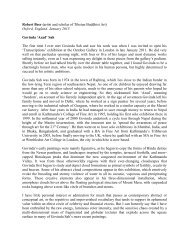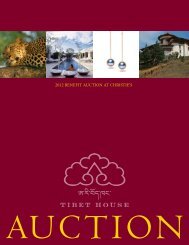Thurman, Essential Tibetan Buddhism Introduction (part) - Tibet House
Thurman, Essential Tibetan Buddhism Introduction (part) - Tibet House
Thurman, Essential Tibetan Buddhism Introduction (part) - Tibet House
You also want an ePaper? Increase the reach of your titles
YUMPU automatically turns print PDFs into web optimized ePapers that Google loves.
her premature death, a treasure teaching called “Heart-Drop of the Dakinis.” He<br />
was a child prodigy, as were most of the greatest Mentor figures, learning to read<br />
and write at five, receiviing initiations at seven, memorizing the Transcendent<br />
Wisdom Sutra. He became a novice monk at Samyey monastery at twelve, wherre<br />
he was educated in the rigorous Kadampa curriculum of Buddhist studies. His<br />
family education was Nyingma and his academic education was Kadampa, and he<br />
also studied Kaagyu and Sakya teachings. At twenty-seven, he me his Root Mentor,<br />
Rigdzin Kumararaja (1266-1343), who taught him the key instructions in the Great<br />
Perfection Tantras of the Nyingma tradition. Under this mentor, he moved out of<br />
the monastery and adopted a contemplative style of life, intensely seeking<br />
meditative realization of the many teachings he had learned. He experienced many<br />
insights, visions and realizations, remembering his former lives, and receiving<br />
further teachings directly from Buddhas and angels. At thirty-two, he began to give<br />
initiations and spiritual teachings to others.<br />
He taught thousands of disciples during many years. He wrote extensive<br />
treatises, traditionally numbered at over two hundred, though quite a number<br />
have been lost. He rebuilt temples, had mystic experiences, and had an<br />
enormous impact on future generations. He was one of the <strong><strong>Tibet</strong>an</strong> “renaissance<br />
men” who accomplished so much it is hard to imagine he had time during his 56<br />
years. His portraits present him with two lotuses above his shoulders, with a<br />
sword of wisdom on the right and a volume of the Transcendent Wisdom Sutra<br />
on the left, thus indicating his membership in the group of “three Manjushris,”<br />
along with Sakya Pandita before him, and Tsong Khapa after.<br />
Longchenpa’s main philosophical accomplishment was his synthesis of the<br />
mystic traditions of the “discovered treasure” teachings received as revelations





